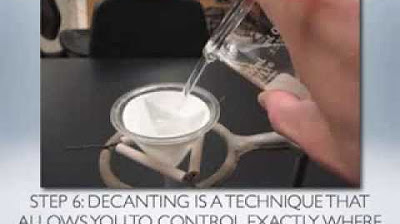Basic chemistry lab skills
Summary
TLDRIn this educational video, Lucy from the University of Glasgow demonstrates essential chemistry lab techniques. She guides viewers through the proper use of a pipette and burette, emphasizing safety with lab gear. Lucy also explains how to prepare a standard solution of sodium chloride, detailing each step from weighing to dissolution and final mixing in a standard flask, highlighting the importance of these skills for aspiring chemists.
Takeaways
- 🧪 Lucy introduces basic chemistry skills including the use of a burette and pipette.
- 👓 Safety first: Always wear lab glasses and gloves before starting experiments.
- 💧 Properly wash and fill a pipette by rinsing it with the solution before use.
- 📏 Read the meniscus at the bottom curve for accurate liquid measurement in the pipette.
- 🔄 Standard practice includes tying hair back and ensuring safety equipment is on.
- 🧴 Clean the burette by ensuring the tap is closed and rinsing it with the solution.
- 🔬 Fill the burette carefully, removing the funnel to prevent drips that alter volume.
- ⚖️ Tare the balance to zero before weighing chemicals for accurate measurements.
- 🌊 Dissolve sodium chloride completely in deionised water for a standard solution.
- 🔄 Mix the solution thoroughly by inverting the flask after adding the stopper.
Q & A
What is the purpose of the video presented by Lucy?
-The purpose of the video is to demonstrate basic chemistry skills, including using a burette, pipette, and preparing a standard solution.
Why does Lucy wear lab glasses and gloves before starting the experiment?
-Lucy wears lab glasses and gloves to ensure safety and prevent contamination during the experiment.
What is the capacity of the pipette that Lucy uses in the video?
-Lucy uses a 20ml pipette in the video.
How does Lucy ensure the pipette is properly filled with the solution?
-Lucy ensures the pipette is properly filled by drawing up the solution until it is half filled, rinsing it around the pipette, and then filling it up to the mark while reading from the bottom of the meniscus.
What safety measures does Lucy take before setting up the burette?
-Before setting up the burette, Lucy ties her hair up, puts on safety specs, and gloves, which is standard practice for safety in the lab.
Why does Lucy pour sodium hydroxide solution into the burette only half full initially?
-Lucy pours the sodium hydroxide solution into the burette half full initially to wash it out and ensure there are no bubbles left in the underside of the tap.
How does Lucy ensure the burette is ready for use after filling it?
-Lucy ensures the burette is ready for use by removing the funnel, opening the tap to let the meniscus fall to the zero point, and then closing the tap.
What is the first step Lucy takes to prepare a standard solution of sodium chloride?
-The first step Lucy takes to prepare a standard solution of sodium chloride is to put on her lab gloves and glasses and tare the balance to zero.
How does Lucy transfer the sodium chloride to the beaker after weighing it?
-Lucy transfers the sodium chloride to the beaker by removing the weighing boat from the balance, adding the chemical, and then putting the boat back on the balance to check the correct mass.
What is the purpose of rinsing the beaker with a pipette during the preparation of the standard solution?
-Rinsing the beaker with a pipette ensures that no chemical is left behind, which could affect the concentration of the standard solution.
How does Lucy ensure the standard solution is well mixed after transferring it to the flask?
-Lucy ensures the standard solution is well mixed by inverting the flask several times after adding the stopper.
Outlines

このセクションは有料ユーザー限定です。 アクセスするには、アップグレードをお願いします。
今すぐアップグレードMindmap

このセクションは有料ユーザー限定です。 アクセスするには、アップグレードをお願いします。
今すぐアップグレードKeywords

このセクションは有料ユーザー限定です。 アクセスするには、アップグレードをお願いします。
今すぐアップグレードHighlights

このセクションは有料ユーザー限定です。 アクセスするには、アップグレードをお願いします。
今すぐアップグレードTranscripts

このセクションは有料ユーザー限定です。 アクセスするには、アップグレードをお願いします。
今すぐアップグレード関連動画をさらに表示
5.0 / 5 (0 votes)






